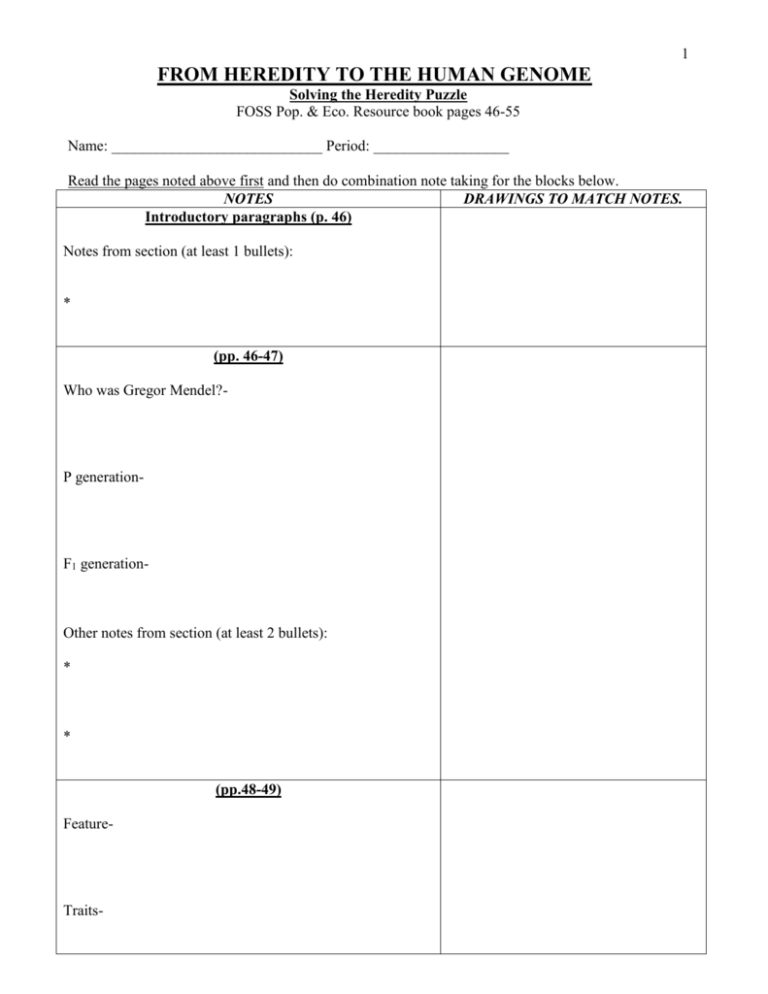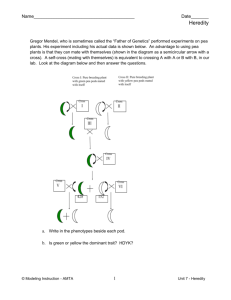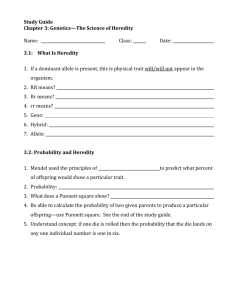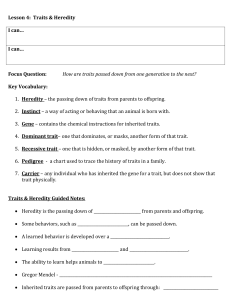Heredity Note Taking Sheet
advertisement

1 FROM HEREDITY TO THE HUMAN GENOME Solving the Heredity Puzzle FOSS Pop. & Eco. Resource book pages 46-55 Name: ____________________________ Period: __________________ Read the pages noted above first and then do combination note taking for the blocks below. NOTES DRAWINGS TO MATCH NOTES. Introductory paragraphs (p. 46) Notes from section (at least 1 bullets): * (pp. 46-47) Who was Gregor Mendel?- P generation- F1 generation- Other notes from section (at least 2 bullets): * * (pp.48-49) Feature- Traits- 2 Dominant- Recessive- Punnett square- Homologues- Notes from section (at least 2 bullets): * * (pp. 50-51) Allele- Gene- DNA- Watson & Crick- Notes from section (at least 2 bullets): * 3 (pp. 52-53) Genotype- Homozygous- Heterozygous- Phenotype- Notes from section (at least 2 bullets): * (pp. 54-55) Notes from section (at least 2 bullets): * 4 PAGES 56-57 A feature of all Larkeys is/are _________________________. A trait within that feature is/are ____________________. Another feature of all Larkeys is/are _____________________. A trait within that feature is/are ____________________. Another feature of all Larkeys is/are _____________________. A trait within that feature is/are ____________________. 5 MODIFIED FROM HEREDITY TO THE HUMAN GENOME Solving the Heredity Puzzle FOSS Pop. & Eco. Resource book pages 46-55 Name: ____________________________ Period: __________________ Directions: Read text pages 46-55 (options- have someone read it to you or get a reading buddy and share the read). Pre-read strategies: Read the title and think about what the reading may be about. Read the section headings and think how it might relate to the title or the reading. Look at the boldfaced words and think how they might relate to the title or the reading. Reading summary: The main focus of this reading is to present the concept of adaptations. They take you on a tour of adaptations of organisms off the coast of California to the Rocky mountains in search of organism’s adaptations. NOTES Introductory paragraphs (p. 46) DRAWINGS TO MATCH NOTES. Choose one thing to draw from your reading and place it in this block. The reading introduces the fact that organisms reproduce to produce offspring (babies). The offspring are similar in their features to their parents. However, the offspring vary in their traits and don’t look or behave exactly as their parents. Offspring INHERITED traits from their parents. (p. 46-47) Early Research into Heredity The reading continues with an introduction to Gregor Mendel. He was the first person to study heredity and patterns of inheritance. They discuss his research on pea plants and their traits. P generation- F1 generation- Choose one thing to draw from your reading and place it in this block. 6 (pp.47-49) Mendel’s Results The reading continues with an explanation of what Mendel discovered. Choose one thing to draw from your reading and place it in this block. Feature- Traits- Dominant- Recessive- (pp.48-49) Punnett squares The reading continues with an explanation of how Punnett squares can be used to explain how traits may be inherited. Punnett square- (pp.49-50) Understanding the Heredity Factor The reading continues with an explanation of how inheritance occurs through Genes. Homologues- A matching pair of chromosomes. Allele- Gene- Choose one thing to draw from your reading and place it in this block. 7 (pp.50-52) What is a Gene? The reading continues with an explanation of DNA and how it was discovered by Waston & Crick. Choose one thing to draw from your reading and place it in this block. DNA- (pp.52-53) Genotype & Pheonotype The reading continues with an explanation of the concept of genotype and phenotype. Choose one thing to draw from your reading and place it in this block. Genotype- The two alleles found for each trait. Homozygous- Heterozygous- Two DIFFERENT alleles found for a trait Phenotype- LARKEYS!!! PAGES 56-57 A feature of all Larkeys is/are _________________________. A trait within that feature is/are ____________________. Another feature of all Larkeys is/are _____________________. A trait within that feature is/are ____________________.




![Biology Chapter 3 Study Guide Heredity [12/10/2015]](http://s3.studylib.net/store/data/006638861_1-0d9e410b8030ad1b7ef4ddd4e479e8f1-300x300.png)


